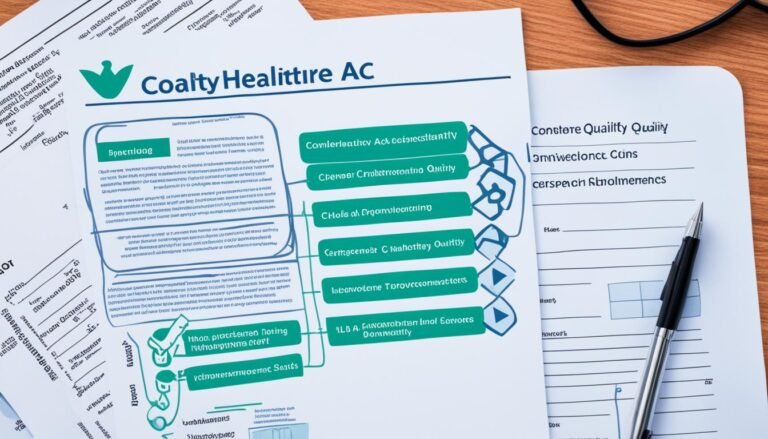Understanding GINA: Your Genetic Privacy Rights
Did you know that a recent survey found over 90% of Americans worry about their genetic information’s safety? In today’s world, our deepest data can be easily analyzed and potentially used wrongly. The Genetic Information Nondiscrimination Act (GINA), created in 2008, helps protect us. It’s a federal law that stops genetic discrimination in health insurance and jobs. Following GINA’s rules is crucial for keeping our genetic privacy safe. It ensures that during hiring or getting health coverage, our genetic info is used rightly and not misused.
Understanding GINA and its importance is key in our information-filled world. It shapes major life choices and opens doors. The law makes clear what’s fair and asserts that our genes shouldn’t limit our futures. Whether you’re curious about your rights or a company aiming to follow GINA, knowing what protections you have is essential.
Key Takeaways
- Gina ensures that individuals’ genetic information remains private and is not used for discriminatory purposes in health insurance and employment.
- Awareness of GINA Act provisions is essential for both individuals and organizations to prevent genetic discrimination and promote equality.
- Compliance with GINA legislation is not just a legal requirement but a commitment to upholding the genetic privacy rights of individuals.
- Understanding the extent of GINA protections and regulations can empower people to exercise their rights effectively.
- Adhering to GINA rights fosters trust and progress in the realms of employment and healthcare by ensuring fair treatment regardless of genetic makeup.
The Genesis of GINA: Safeguarding Genetic Privacy
The creation of the Genetic Information Nondiscrimination Act (GINA) marked a big step forward. It built strong protections for our genetic privacy. Now, genetic research can’t be used to treat people unfairly.
President George W. Bush’s Historical Signing
President George W. Bush made history by signing GINA into law on May 21, 2008. This act formed a defense against discrimination based on genetics. It focuses on protecting us in jobs and health insurance.
The Long Road to GINA: Advocacy and Development
Creating GINA took 13 years of hard work and dedication. Many people, including politicians, patients, and scientists, came together. Their goal was to protect us from the wrong use of our genetic info.
The Impact of the Human Genome Project on GINA
The Human Genome Project really pushed the need for GINA into the spotlight. This big project showed how great genetic research can be. But it also showed we needed strong laws to keep us safe.
GINA shows our promise to keep genetic research safe and beneficial for everyone. It’s about making sure no one faces discrimination because of their genetics.
Core Provisions of the Genetic Information Nondiscrimination Act (GINA)
The Genetic Information Nondiscrimination Act, or GINA, fights genetic discrimination in the US. It protects people in jobs and health insurance. The law makes sure everyone is treated fairly, no matter their genes.
In the workplace, GINA stops employment discrimination. The Equal Employment Opportunity Commission (EEOC) watches over this. They make sure employers don’t use genetic info to make job decisions. This helps keep everyone’s rights safe at work.
EEOC’s Enforcement of GINA in the Workplace
The EEOC works hard to keep GINA’s rules in place. They stop bosses from peeking at your genetic details. This helps make sure jobs are given fairly, without genetic bias.
The Role of Health and Human Services in GINA Regulation
For health insurance, the Health and Human Services (HHS) department is key. They set rules to stop insurance discrimination based on genes. HHS makes sure insurance is fair for everyone. They respect your privacy and treat you right, no matter your genetic makeup.
Defining Genetic Information Under GINA
The Genetic Information Nondiscrimination Act (GINA) protects people from being unfairly treated. It makes sure that your genetic info, like your family’s health history and genetic test results, is safe. These are all kept private under GINA.
The Inclusion of Family Medical History
Your family health history gives clues about your own health risks. GINA covers this information. It helps predict health issues you might face, keeping it private and safe.
The Relevance of Genetic Tests and Clinical Research
Genetic tests show if you’re at risk for certain diseases. Taking part in clinical research about genetics is also protected. GINA makes sure this private info stays secure, so you don’t face discrimination.
It’s vital for employers and health insurers to understand what GINA protects. They must follow GINA to avoid discriminating based on genetics.
| Aspect of Genetic Information | Relevance to GINA |
|---|---|
| Family Medical History | Used for assessment of potential hereditary health risks |
| Genetic Tests | Identify individual genetic traits and predispositions to diseases |
| Clinical Research Participation | Potentially reveals individual genetic information that requires protection |
GINA’s rules are key to stopping discrimination. They ensure everyone treats your health information with respect, in jobs and health insurance.
Understanding Discrimination Based on Genetic Information
The Genetic Information Nondiscrimination Act (GINA) plays a pivotal role in stopping unfair treatment based on genetics. This unfairness can affect jobs and health insurance. It prevents employers and insurers from making adverse decisions based on one’s genetic info.
Genetic discrimination can make people avoid important genetic tests. These tests are key for informed healthcare choices. Knowing about GINA and your rights helps fight against job and insurance discrimination due to genetics.
| Protected Activities Under GINA | Forms of Prohibited Discrimination |
|---|---|
| Undergoing genetic tests | Denial of health insurance based on test outcomes |
| Participation in clinical research | Job placement decisions influenced by genetic makeup |
| Accessing genetic counseling services | Imposing higher insurance premiums due to family history |
| Sharing family medical history with a physician | Withholding promotions or benefits because of genetic risks |
Every person deserves equal treatment and privacy, no matter their genes. By learning about GINA, you can protect your rights. Employers and insurance companies also must follow the law. This makes sure everyone is treated fairly and with respect.
Genetic Information Nondiscrimination Act (GINA) and Employment Regulations
The Genetic Information Nondiscrimination Act (GINA) has changed how jobs are given and managed. It sets strong rules against genetic information discrimination. GINA makes sure hiring and promotions are fair. It bases them on skill, not genetic traits.
How GINA Alters Hiring and Employment Practices
GINA stops employers from using genetic info when hiring. This rule covers everything from interviews to placing someone in a job. It makes sure everyone has a fair chance, no matter their genes.
Promotions, Layoffs, and Benefit Considerations Under GINA
GINA also applies to promotions and layoffs. It stops unfair job actions using genetic info. This way, everyone has the same chance to move up. They’re also protected in job cuts. Plus, GINA prevents bias in employee benefits. This creates a fair workplace.
| Employment Aspect | GINA Compliance |
|---|---|
| Hiring | No collection or use of genetic information |
| Job Placement | Decisions based on qualifications without genetic bias |
| Promotions | Merit-based advancements without factoring in genetic data |
| Layoffs | Decision-making process immune to genetic information consideration |
| Employee Benefits | Benefits offered equitably, disregarding an individual’s genetic background |
The start of the Genetic Information Nondiscrimination Act is big for civil rights. GINA helps us get closer to ending genetic information discrimination. It makes workplaces welcome everyone. This respects the worth and rights of each person.
Preventing Harassment Related to Genetic Information
The Genetic Information Nondiscrimination Act (GINA) brings important protections against harassment over genetic information at work. Employers must create a respectful culture. Co-workers also have to help in keeping the workplace free from harassment.
Distinguishing Between Harmless and Illegal Conduct
Knowing what’s okay to say and what’s not is key. Sometimes, what seems like just talk can be harassment under GINA. It’s vital to know when comments can hurt someone because of their genes.
The Role of Employers and Co-workers in Preventing Harassment
Employers must do more than just follow the law. They should educate everyone about why harassing someone over their genes is wrong. Co-workers should be ready to support and protect each other from any harassment.
| Stakeholder | Responsibilities Under GINA | Actions to Prevent Harassment |
|---|---|---|
| Employers | Develop and enforce anti-harassment policies. | Conduct training sessions on the implications of GINA. |
| HR Departments | Ensure confidentiality of genetic information. | Implement reporting mechanisms for harassment cases. |
| Co-workers | Promote a culture of inclusivity and respect. | Support peers in reporting incidents of harassment. |
| Leadership | Set a zero-tolerance policy towards discrimination. | Model respectful behavior concerning genetic privacy. |
If we follow these steps and embrace our roles, we’ll honor the GINA Act. We’ll make work a place that protects everyone’s genetic info.
Legally Obtaining Genetic Information: The Exceptions to GINA
The Genetic Information Nondiscrimination Act (GINA) protects us from genetic information misuse. But, it has some exceptions. It’s important to know about these legal ways to get genetic information.
Inadvertent Discoveries and Wellness Programs
Accidentally finding genetic information is an exception. If an employer or insurer finds genetic info by chance, it’s not breaking GINA. This can happen if they overhear something or see information that’s publicly available.
Wellness programs also have an exception. These programs encourage healthy living. Employees can share genetic info with these programs if they agree. It’s okay as long as the data is used properly and not for discrimination.
Genetic Information in the Context of FMLA and Law Enforcement
Another exception is for the Family and Medical Leave Act (FMLA). Employers might ask for genetic info for FMLA leave. This is if the leave is for someone with a genetic condition.
Law enforcement can use genetic information too. This helps them identify suspects, victims, or remains. It’s a special case that GINA allows. This helps solve crimes while respecting the law’s protective goals.
Understanding GINA’s exceptions is key. This knowledge helps people and organizations use genetic info legally and responsibly.
Privacy and Confidentiality: GINA’s Handling of Genetic Data
Keeping genetic data private is key in the Genetic Information Nondiscrimination Act (GINA). This law sets rules for GINA compliance. It aims to safe keep genetic info.
GINA makes sure key groups handle genetic data carefully. These include employers and health insurers. They must protect this data and keep it private.
Still, GINA allows for some exceptions. Sometimes, sharing genetic info is necessary, like for GINA compliance checks or legal orders. Let’s look into these exceptions more closely:
| Scenario | Entity | Conditions for Disclosure |
|---|---|---|
| Investigation Compliance | Government Officials | Strictly for purposes of determining compliance with GINA regulations |
| Legal Proceedings | Courts | Pursuant to a court order where genetic information is relevant |
The main goal of Genetic Information Nondiscrimination Act is to stop discrimination. It ensures people that their genetic info is handled carefully. By following this law, we help make sure genetic data is used right and kept safe.
Limits and Bounds of GINA’s Protections
The Genetic Information Nondiscrimination Act (GINA) helps protect our genetic info in health insurance and jobs. But, GINA does not cover everything. It misses small businesses and some insurance types.
Small Businesses and Insurance Exemptions
Genetic Information Nondiscrimination Act rules don’t apply to companies with under 15 workers. This leaves many without protection against genetic bias. Small businesses cite high costs for not following GINA. Yet, everyone’s genetic privacy should be protected, no matter the company size.
Gap Areas: Life and Long-Term Care Insurance
GINA doesn’t cover life insurance, long-term care insurance, or disability insurance. In these areas, your genetic info could change your insurance costs. The lack of protection might stop people from getting genetic tests or joining genetic studies. They fear it could affect their insurance.
| Insurance Type | Coverage Under GINA | Areas for Legislative Action |
|---|---|---|
| Health Insurance | Covered | N/A |
| Employment | Covered for companies with 15+ employees | Extension to all employer sizes |
| Life Insurance | Not Covered | Include provisions to prohibit genetic discrimination |
| Long-Term Care Insurance | Not Covered | Include provisions to prohibit genetic discrimination |
The Genetic Information Nondiscrimination Act is crucial for protecting our genetic privacy. But we need to make it stronger. By covering small businesses and removing insurance exemptions, we can protect everyone better.
Advancing Genetic Research with GINA’s Protections
The heart of modern genomics advancements is careful handling of sensitive data. The Genetic Information Nondiscrimination Act (GINA) is crucial here. It protects people from the misuse of their genetic info. This lets researchers explore new areas without risking the privacy and freedom of participants.
Encouraging Participation in Genetic Studies
Thanks to GINA, more people are willing to join genetic studies. It makes them feel safe from discrimination in health insurance and jobs. This helps science, as having many different participants is key to powerful genetic research that can change healthcare.
Resources and Guidance for Researchers
Researchers have a lot of resources to help them follow GINA rules. The National Institutes of Health offers detailed advice for ethical genomic research. Easy access to these tools helps scientists keep participant info private, following GINA’s rules.
Conclusion
In our discussion about the Genetic Information Nondiscrimination Act (GINA), we learned about its key role. It helps protect our genetic privacy rights and fights genetic discrimination. This important law, known as GINA, shows we’re committed to matching our morals with scientific progress. It ensures fairness and equality for all.
Everyone needs to know about GINA’s rules. This includes people, businesses, and health insurers. Knowing these rules helps us follow the law and support the rights GINA protects.
GINA offers strong protections against genetic discrimination. This makes our society more respectful and private. Yet, it’s vital to know the limits of GINA protections too. With this knowledge, we can spot the areas that need more work. We can also see where more rights could be added.
For those involved in genetic research, GINA is like a promise. It ensures their efforts won’t lead to unfair treatment at work or home. Following GINA helps us look forward to a future. In this future, chasing new knowledge goes together with respecting everyone’s privacy and rights.
We end this discussion seeing GINA as more than laws. It’s a moral guide that leads us to a more aware, careful, and welcoming society.







